Scroll through the lesson and click on notation/video/audio links to load the interactive players.
Please subscribe to get full access to all lessons for only $7.95/month PLUS 1 week free trial.

Riff Interactive lessons are
LESS expensive and
MORE interactive than alternatives!
More Info
|
|

Beginning Guitar V - Rhythm
Lesson 2 check your tuning
Lyle: This lesson is all about keeping your rhythm arm at a steady beat, and
adding up strokes. You'll be using the open C chord for this
lesson:
C
chord
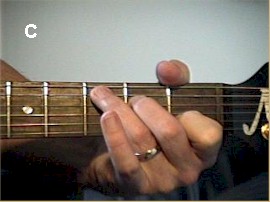
C chord
Lyle:
Make sure you are muting the big 6th string with either the tip of your 3rd
finger or the tip of your thumb.
Lyle: The first rhythm is the easy one. Strum
down on each beat while you tap your foot and count out
loud:
rhythm
1
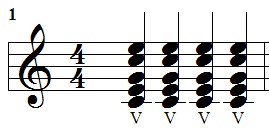
rhythm 1
rhythm 1
Lyle:
Here's a basic jam track you can use to play along with:
Jam Track -
drums and bass
Lyle:
Now you'll add a single up stroke at the end of the measure, right after beat 4.
When you count out loud the up stroke, use the word "and". So in the next rhythm
count out loud - 1, 2, 3, 4, and...
rhythm 2
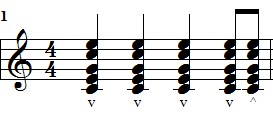
rhythm 2
rhythm 2
Lyle:
You can loop the TAB notation to help you play along or try using the
looping jam track. Notice that your strumming arm is going at
exactly the same speed as in rhythm 1. The only thing different is you're
choosing to hit the strings on the way up after beat 4.
It sounds like you're going faster but you're not.
Lyle: Next exercise is adding an up strum after
the 3rd beat:
rhythm
3
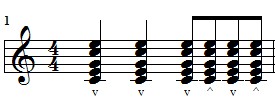
rhythm 3
rhythm 3
Lyle: I
know you're tapping your foot and counting out loud.....Keep your foot going
down on all 4 of the "down beats", the 1, 2, 3, and 4 beats of the measure.
Lyle:
Are we doing ok out there?
zack: I get the rhythm, but I'm having a hard time with
the up strokes?
Lyle: When you watch the video clips you'll
notice my strumming arm never changes speed, it just sounds like it because of
the added up strums. One of the secrets to being a smooth
sounding guitar player is being able to master these simple
rhythms.
Lyle: Let's add another up stroke after the 2nd
beat of the measure:
rhythm 4

rhythm 4
rhythm 4
Lyle: Rhythm 4 is a popular rhythm that is used
in many style of music.
Remember you can loop the TAB notation to help you play along. You can even SLOW
it down!
Lyle: Here's what it would be like if you had up
strokes after each down beat:
rhythm 5
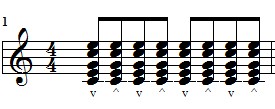
rhythm 5
rhythm 5
zack: I'm
having some trouble strumming the up strokes, I'm just not hitting all of the
strings
Lyle: It's not real important you hit all the
strings of the chord, as long as you are keeping the
beat. You'll learn to smooth out the strum. Watch
my video clip examples, you see how my arm stays at the same speed/pace through
all these rhythms.
Lyle: Here's a rhythm that's just a little
different. You'll strum up after the 2nd and 4th beat
only:
rhythm
6
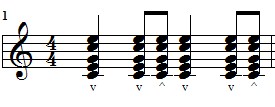
rhythm 6
rhythm 6
Joel: Waltz
beat. cool. :)
Lyle: No, it's not a waltz beat, it's more of a
country rhythm. A waltz beat has only 3 beats per measure, this has 4 beats per
measure.
Lyle: If you've made it past each rhythm riff so
far, try playing them all back to back like in the following
example:
all 6
rhythms
all 6
rhythms
Lyle:
Remember you can loop the TAB notation and even slow it down to help you play
the exercise along with me.
Lyle: You really have to concentrate hard to be
able to 1. memorize each rhythm and what comes next, 2. keep tapping your foot
and counting out loud while perfecting your smooth strum.
Lyle: That's all for now, thank you and see you
in the next lesson as we work on more
rhythms!
|
<< load notation from left
|
|
<< load audio from left
|
<< load audio from left
|